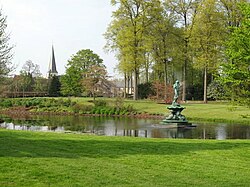History
The genealogy of this family can be traced back to an act of 19 April 1535, though they claim to have had the status of nobility since the late 14th century. This act mentions Willem Spoelberchs as the husband of Catherina van Hoegaerde, and as being the son of Wouter Spoelberchs. [1] [2]
In 1828 Jean-Charles-Laurent-Joseph de Spoelberch de la Bawette inherited the Kasteel Drie Torens (Three Towers Castle) in Londerzeel. [3] Another castle obtained by marriage is in Wespelaar.
Members of the family bear the title of Viscount de Spoelberch. Today this noble house is one of the wealthiest families of the kingdom; their private fortune is an estimated €14 billion. [4]
André de Spoelberch, who died in 2017, was among the twenty wealthiest Belgians until his death. Part of that wealth was due to his stake in the global beer brewing company AB InBev. [5]
This page is based on this
Wikipedia article Text is available under the
CC BY-SA 4.0 license; additional terms may apply.
Images, videos and audio are available under their respective licenses.


